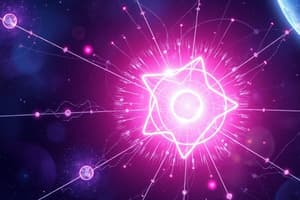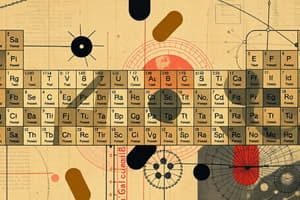Podcast
Questions and Answers
What happens to light when it appears brighter in the sky?
What happens to light when it appears brighter in the sky?
- It releases later
- It is reflected more (correct)
- It travels faster than sound
- It appears dimmer
Which type of tropism is the response to light?
Which type of tropism is the response to light?
- Thigmotropism
- Phototropism (correct)
- Geotropism
- Hydrotropism
What does it mean that water has a higher specific heat than iron?
What does it mean that water has a higher specific heat than iron?
- Water is hotter than iron
- Water is denser than iron
- Water heats more slowly than iron (correct)
- Water heats more rapidly than iron
What is the probability that all daughters of a colorblind man and a woman with normal vision will be?
What is the probability that all daughters of a colorblind man and a woman with normal vision will be?
Why do albino corn seedlings eventually die?
Why do albino corn seedlings eventually die?
What is the term for the response of Mimosa pudica to touch?
What is the term for the response of Mimosa pudica to touch?
What is the main reason why sound travels slower than light?
What is the main reason why sound travels slower than light?
What is the characteristic of an organism that has a response to a given stimulus?
What is the characteristic of an organism that has a response to a given stimulus?
What is the name of the plant that is locally known as Makahiya?
What is the name of the plant that is locally known as Makahiya?
What is the effect of a colorblind man marrying a woman with normal vision on their sons?
What is the effect of a colorblind man marrying a woman with normal vision on their sons?
Study Notes
Electron Configuration
- A hypothetical element with an electron configuration of 1s22s22p63s23p5 has an atomic number of 11.
- It is a member of Group V, also known as the Nitrogen Group.
- It is located in the fifth position of the p-block, along the third period of the periodic table.
Boyle's Law
- Boyle's Law states that the volume of a gas is inversely proportional to the pressure.
- An example of its application is a tire becoming harder as more air is pumped into it.
Biomolecules
- Despite the diversity among organisms, they are all made from the same set of biomolecules composed of monomeric units.
- The exception is ash from burnt rice hulls and straws, which is rich in compounds that can neutralize acidic soil.
Acid Rain
- Acid rain occurs when sulfur released in burning fossil fuels combines with water in the atmosphere.
- It does not occur when carbon dioxide combines with water in the atmosphere, or when phosphorus-rich water in lakes evaporates to form phosphoric acid.
Plant Propagation
- When a gardener propagates a plant by taking cuttings, he covers the plant and pot with a lightly perforated polythene bag to reduce transpiration and prevent water loss.
Nitrogen Cycle
- It is difficult to integrate nitrogen gas from the atmosphere into the nitrogen cycle of the biosphere because nitrogen is very abundant in the atmosphere.
- Nitrogen is not quickly absorbed by living organisms, and oceans do not quickly absorb nitrogen gas.
Biogeochemical Cycles
- After a lightning strike, mushrooms thrive due to the involvement of the nitrogen cycle.
Seasonal Winds
- PAGASA announces the approach of seasonal winds known as Amihan and Habagat, which are internationally known as Northeast and Southwest monsoon.
Food Webs
- If all snakes are killed in a simple food web, the population of frogs and grasshoppers would increase.
Fog Formation
- Fog forms when the ground has lost heat by radiation, and the air near the ground cools, causing the water vapor to condense.
Earthquake Measurement
- Intensity refers to the strength of an earthquake, while magnitude refers to the degree of destruction it causes at the epicenter.
- Intensity cannot be measured while magnitude can be measured using a seismograph.
Refrigeration
- It is not advisable to repeatedly open the door of a refrigerator because it leads to wastage in electrical energy.
Speed of Sound
- The speed of sound is usually lowest in gases and highest in solids.
- This is because the particles in a gas are farther apart, making it harder for the sound wave to propagate.
Mirrors
- A convex mirror is used in cars to give the driver a wider area and smaller image of the traffic behind.
Thunder and Lightning
- We hear thunder some seconds after seeing lightning because light travels faster than sound.
Specific Heat
- Water has a higher specific heat than iron, meaning it heats more slowly than iron.
Colorblindness
- If a colorblind man marries a woman with normal vision and no history of the disease, it is most probable that all of their daughters will be carriers.
Plant Growth
- Albino corn seedlings may grow several inches tall but will eventually die due to their inability to produce their own food.
Organismal Response
- Mimosa pudica, or Makahiya, responds to a given stimulus by closing its leaflets when touched, a phenomenon called thigmotropism.
Studying That Suits You
Use AI to generate personalized quizzes and flashcards to suit your learning preferences.
Related Documents
Description
Test your understanding of electron configuration and Boyle's Law with this quiz. Identify the hypothetical element and understand the application of Boyle's Law.




